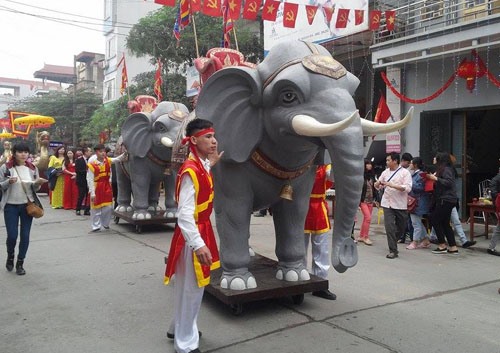 |
| Gentle beasts: Elephants are a major part of the cheo tau festival - a unique traditional culture in Tan Hoi Commune, Ha Noi’s Dan Phuong outlying district. Photo btgcp.gov.vn |
Viet Nam News
In 1922, the last cheo tau folk singing festival took place in the ancient villages outside the capital. It seemed that the art form, which had been celebrated in festivals since 1683, would be lost to history. But for the last two decades, local researchers and enthusiasts have teamed up to revive the practice. Thuan Phuong reports.
The ups and downs of Vietnamese history over the last hundred years nearly claimed another victim: the art of singing while rowing (cheo tau in Vietnamese). The precious art form has been battered by wars and social change. Now, however, advocates are stepping up to call for its preservation.
The local folk music, which has its roots in ancient village festivals in Ha Noi’s Dan Phuong outlying district, is being recovered thanks to the constant support, passion and enthusiasm of elderly folk artists in Tan Hoi Commune.
According to local folk artists and researchers, the first official cheo tau festival was held in 1683.
Because it lasted for several days and involved more than 200 singers, the event was only held once every 25 years.
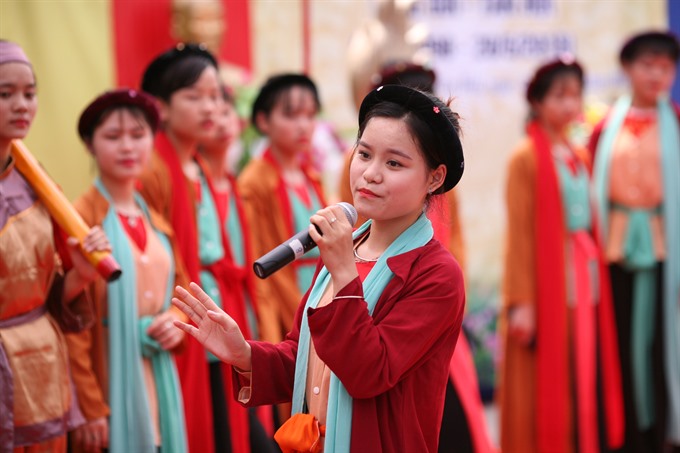 |
| Leading ladies: Most of the cheo tau singers are beautiful women. VNA/VNS Photo Dinh Thuan |
The latest full-scale festival took place in 1922. Locals thought it was finished for good -- until 1998, when the Voi Phuc Temple and Van Son Tomb in the commune were recognised as historical relics, and the festival resumed on an annual basis, but on a smaller scale.
Local people in Tan Hoi Commune, especially the members of the Cheo Tau Singing Club, contributed greatly to restoring the festival.
The club was established in the commune in 1998 to accelerate the collection of the missing folk songs as a way to preserve the tradition.
The head of the club, Ngo Thi Thu, said members of the club had joined researchers to visit every house to record the folk tunes sung by elderly people.
“We have just learnt some of the songs performed at the festival. This is only part of the research on this art form," said Thu.
After 20 years of operation, the club, which had only about 20 members in the first year, now has attracted the participation of more than 60 locals.
The Ha Noi cultural authority has recently awarded the club with a certificate of merit in recognition of their contribution and efforts in preserving and developing the heritage of the cheo tau folk music.
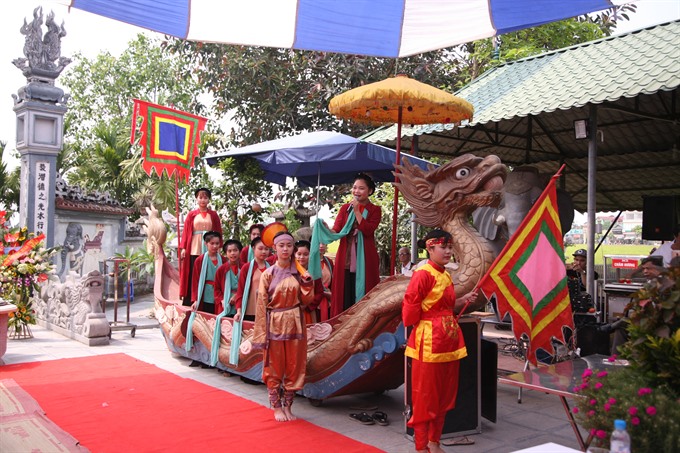 |
| Carrying the torch: A cheo tau performance in Ha Noi’s Dan Phuong District. — VNS Photo Dinh Thuan |
Dong Sinh Nhat, a senior folk singer, said that even after it was lost for nearly 100 years, cheo tau now has gradually become popular in local cultural activities thanks to a programme to recover the music tunes and master singers. The programme has overcome the obstacles posed by the passage of time and the loss of memory.
Nhat said it was fortunate that several elder local women, including Tien Thi Luc, Kim Thi Ba and Nguyen Thi Nam, who had attended the 1922 festival, could remember many old tunes.
The event was so impressive that the women memorised many rhythms and could sing them very well at the 1998 festival.
Nhat said he and other members of the club met the master singers time and again to convince them to teach those folk tunes to young people.
“That’s one of the ways cheo tau was preserved,” said the local senior folk artist.
According to tradition, the cheo tau singing festival begins on the full-moon day and ends on the 21st day of the first lunar month. During the seven days and nights, people from neighbouring villages take turns singing from dawn to dusk.
The festival begins with a ritual ceremony held in Voi Phuc Temple followed by a procession to the village communal house.
Cheo tau is only performed in Tan Hoi Commune.
The origins of the festival and the boat rowing songs in Tan Hoi continue to fascinate researchers.
Some from Ha Noi’s Folk Culture Association said there were three legends about the origins of cheo tau in Tan Hoi, but it was unclear which one was the most accurate.
The first legend says local villagers select a year with moderate weather and a bumper crop in which to hold the festival, dedicated to General Van Di Thanh (1380-1416), who defeated the Chinese Ming invaders in the 15th century.
Meanwhile, Professor To Ngoc Thanh, president of the Viet Nam Folk Arts Association, said the images of elephants and female singers in cheo tau performance were proof that cheo tau originated in the era of Trung sisters around AD 12 – 43.
According to another legend, it likely came from the military negotiations between Ly Phat Tu and Trieu Quang Phuc during the war between years of 544 and 571.
In a cheo tau performance, local people make giant wooden elephants and boats with wheels to transport them.
Most of the festival participants are beautiful women.
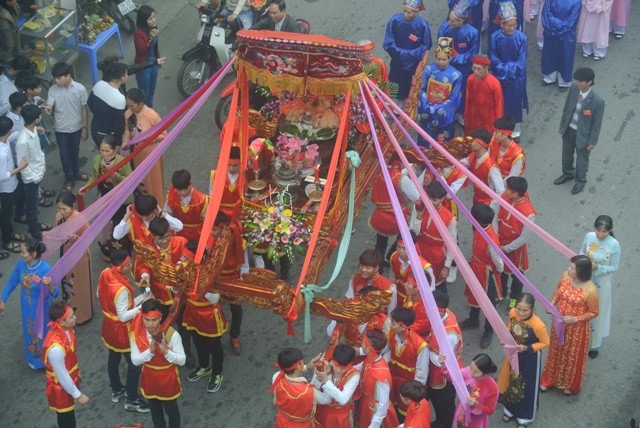 |
| On the march: Cheo tau festival include a procession by villagers in Tan Hoi Commune. — Photo btgcp.gov.vn |
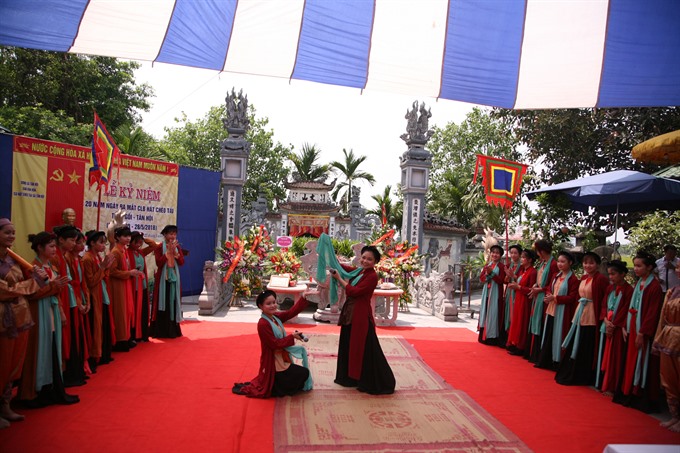 |
| Hat cheo tau tai huyen Dan Phuong - VNA/VNS Photo Dinh Thuan |
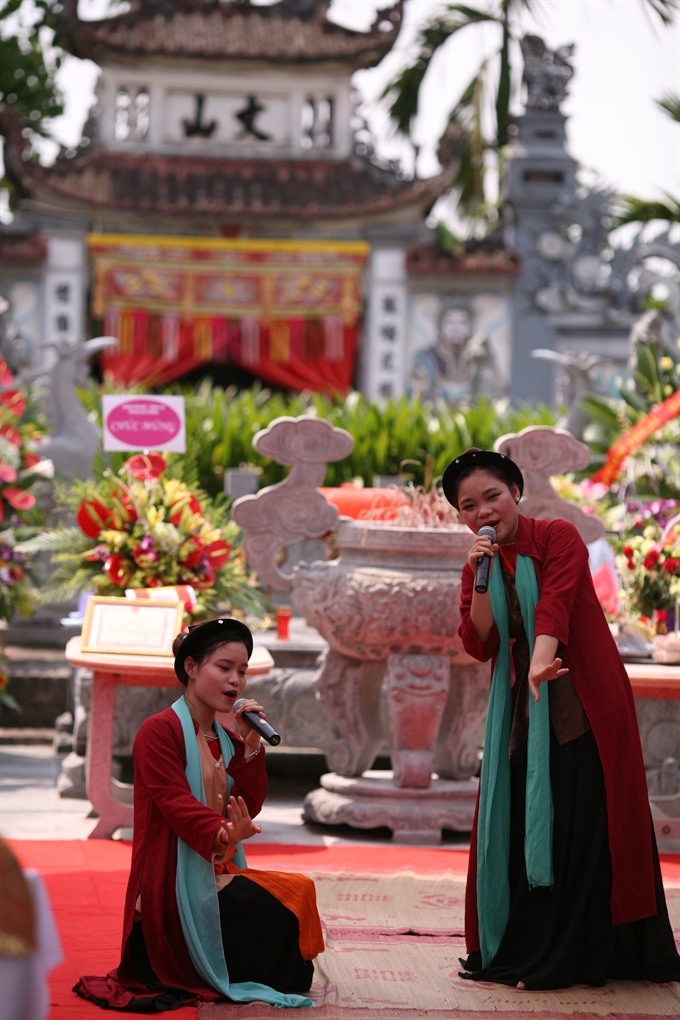 |
| Reviving the art: The local folk music, which has its roots in ancient village festivals in Ha Noi’s Dan Phuong outskirts District, is being recovered thanks to the constant support, passion and enthusiasm of elderly folk artists in Tan Hoi Commune. VNA/VNS Photo Dinh Thuan |
The older ones act as the boat’s captain while the younger ones, aged 13 to 16, are the crew. These people and the elephant tamer sing folk tunes while rowing.
Preparations for the festival are carefully done by people from villages of Thuong Hoi, Thuy Hoi, Vinh Ky and Phan Long.
The two villages Thuong Hoi and Thuy Hoi each will make a wooden dragon boat of 4-5m long and about 2m wide. In the middle of the boat is a parasol and under the boat are wooden wheels so that people can move the boat easily.
Vinh Ky and Phan Long villages each make a wooden elephant about 2.5m high, nearly 3m long, with flags and parrots above.
The festival starts with a procession in the early morning on the 14th day of the first lunar month of the year.
The procession is accompanied by other cultural activities including kylin and dragon dances.
Followed by the elderly people and all villagers, the procession goes to Van Son Tomb where there is a celebration of worship, then the palanquin procession continues to Voi Phuc Temple.
When they arrive at the tomb and temple, the singing club performs.
In the morning of lunar January 15, festival goers continue to worship at the tomb and the temple until the end of the day.
The key feature of the festival is the boat-rowing show with the cheo tau singing between crews of the two dragon boats prepared by the villages.
These boats, each with a model of several elephants standing in the back, are not launched in water but only used for performances on land. VNS
OVietnam